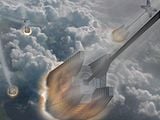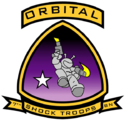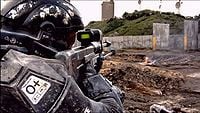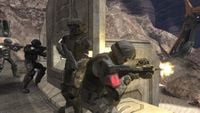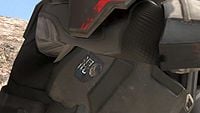Orbital Drop Shock Troopers
From Halopedia, the Halo wiki
Template:Infobox Military Unit
- "We go feet first, sir!"
- — Shock Troops to Major Antonio Silva, aboard the UNSC Pillar of Autumn.
The Orbital Drop Shock Troopers (ODST) are an elite group of UNSC Marines that specialize in special warfare tactics. The ODSTs are one of the primary Special Operations units of the United Nations Space Command, and is under the command of UNSC Naval Special Warfare Command.
Background
The Orbital Drop Shock Troopers are a Special Operations Force in the UNSC Military, they are sometimes referred to as the 105th Special Forces. The ODSTs are under the operational authority of Naval Special Weapons, a sub division of Naval Special Warfare - their methods of operation allow them to conduct missions against targets that more conventional forces cannot approach undetected. ODSTs are recruited from the Special Operations Groups of all the nations of the Unified Earth Government and is a strictly all volunteer force. Potential ODSTs are selected because of their performance in their chosen MOS, every ODST candidate is a veteran from another Special Operations outfit and therefore have already gone through at least two layers of screening and months of intense training — not counting the years of training received before volunteering for the ODSTs. There is no age or gender bias — as long as the candidate meets the physical and mental requirements they are guaranteed the opportunity to try out for the ODSTs. Once in the ODSTs, a candidate's training continues - its entrance requirements serve as a third layer of screening upon two more, where applicants would have theoretically failed to pass. Candidates would, therefore, already have extensive experience in conducting the types of high-risk missions that the Orbital Drop Shock Troopers typically perform.
ODST units are not embedded within conventional UNSC forces, they do however participate in joint operations, and tend to be force multipliers - increasing the effectiveness, willingness, and morale of those they fight alongside. ODST combat teams usually consist of six to eight - with each combat team specializing in a particular mission set, but they are expected to be flexible enough to adapt to any given situation. These combat teams however can vary from company to company. Each combat team also consists of ten to fourteen operators, each of whom has a specific function on the team. ODSTs are known for their unusual methods of insertion, dropping from orbit onto terrestrial environments. Similar to their Infantry counterparts, the ODSTs maintain units of varying strength aboard many UNSC vessels and Installations.
The ODSTs perform highly specialized, small scale, high-risk operations including:
- Deep Ground Surveillance or Long Range Reconnaissance: Patrols in small groups, in uniform, usually far behind the enemy lines. While DGS units may direct air or artillery strikes against enemy positions, they strive to be unobserved, and have only self-defense, not DA, capability. Groups engaging in surveillance deep behind enemy lines, are commonly known as "Long Range Reconnaissance Patrols" or LRRP's.
- Direct Action: Short-duration strikes and other small-scale offensive actions conducted as a special operation in hostile, denied, or politically sensitive environments and which employ specialized military capabilities to seize, destroy, capture, exploit, recover, or damage designated targets. Direct action differs from conventional offensive actions in the level of physical and political risk, operational techniques, and the degree of discriminate and precise use of force to achieve specific objectives.
- Unconventional Warfare: Military and paramilitary operations, normally of long duration, predominantly conducted by indigenous or surrogate forces who are organized, trained, equipped, supported, and directed in varying degrees by an external source. It includes guerrilla warfare and other direct offensive, low visibility, covert, or clandestine operations, as well as the indirect activities of subversion, sabotage, intelligence gathering, escape and evasion.
- Counter-Terrorism Operations: The response to terrorist threats and/or acts, both real and imputed.
- Counter-Contraband Operations: Missions undertaking the recapturing of smuggled/stolen goods.
- Personnel and Special Equipment Recovery/Capture: The recovery/medical treatment of friendly personnel in combat environments, as well as the capability of capturing high valued individuals and any equipment.
History
| There is more information available on this subject at Orbital Drop Shock Troopers on the English Wikipedia. |
Origins
The idea of inserting highly trained troops behind enemy lines from high altitudes has its roots in the paratroopers of 20th and 21st century fame, who dropped frequently behind enemy lines to capture strategically important targets in anticipation for a larger advance by more conventional and numerous military forces.
Such troops were first used prior to World War II by Italian and Soviet forces, but the first serious application of the doctrine was seen in 1940 by the German Air Force in World War II to overrun the Allied positions in Denmark, the Netherlands and the legendary Eben Emael fortress in Belgium. Paratroops were also used to capture the entire island of Crete. Later, during the Battle of Normandy known as Operation Overlord on June 6th 1944, when two American Airborne Divisions and one British Airborne Division landed behind enemy lines in Normandy, France on D-Day and again in Operation Market Garden. Although they were only marginally successful, they proved the concept of paratroops as useful and effective in large scale warfare.
While the concept of dropping human soldiers from orbit had been around since the early 21st century, the establishment of the UN Marine Corps in 2163, would be the historic first deployment of the future 105th infantry in the Martian Campaign against the Neo-Communist Koslovics.[1] The UN Marines historic first drop onto Mars in support of UN led war against the Koslovics and the Frieden forces not only proved the feasibility of such an option, but also the effectiveness of deploying soldiers from orbit. The success of the Argyre Planitia Campaign by the UN, and its participants of the first drop onto martian soil would become the predecessors, or early members, to the modern ODST units.[2]
At the conclusion of the Rain Forest Wars and the Jovian Moons Campaign the Orbital Drop Shock Troopers was a fully established force and participated in every high risk operation during those conflicts, however at the conclusion of these conflicts in 2170 with the signing of the Callisto Treaty[3] and the subsequent years that followed, the ODSTs saw little action as more political, and more important issues such as overpopulation and famine and a massive military with no purpose gripped the postwar nations of Earth. The first major combat reemergence of the ODSTs occurred in 2490 during the beginnings of the civil conflict between the UEG and the Insurrection. For the years leading up to 2525 the ODSTs would once again conduct high risk operations against the Insurrectionist, to either stop the enemy before they could carry out attacks against supporters, and officials of the Earth Government or to cut off major suppliers to the Insurrectionists.
Human-Covenant War
On November 1st 2525 the UNSC moved into a full alert status after the devastating and horrifying first contact with the Covenant at Harvest - this marked a change in objectives for the ODSTs, who up until that point were fighting the Insurrectionist and while the ODSTs primary focus was now on the Covenant, ODST combat teams from time to time were deployed against Insurrectionist. The ODSTs would participate in some of the most critical engagements in the war and also take part in the most high risk missions ever in the history of mankind.
While multiple divisions of ODSTs participated in the first ground engagements that occurred at the beginning of the war, the first major operation the ODSTs as a force participated in was the enforcement of the Cole Protocol in 2535 in which multiple ODST combat teams would board commercial and private vessels, purge their navigation databases then ensure that military escorts take them to their final destination. A group of ODSTs would later be captured and taken to the Rubble and would later go on to defeat a Kig-Yar plan to trick the inhabitants of the Rubble out of their navigation data - this is believed to be the first joint operation between ODSTs and SPARTAN-IIs despite the tensions that would later surface between the two units. ODSTs would also go on to participate in major engagements like the Jericho Theater of Operations, The Battle of Mamore, The Battle of Draco III, The Battle of Coral, The Battle of New Jerusalem, The Battle of Sigma Octanus, The Battle of Tribute, The Battle of Ariel and many other countless engagements. These all pale to the The Fall of Reach in which countless ODSTs fought and died defending key strategic locations on the planet.
A large contingent of ODSTs however, were stationed on the UNSC Pillar of Autumn that made a blind slipspace jump away from the Epsilon Eridani system, discovering the long abandoned Installation 04. During the Battle of Installation 04, the 22nd Battalion, led by Major Antonio Silva and First Lieutenant Melissa McKay, began to operate as a guerrilla force by conducting hit-and-run operations against the Covenant soldiers of the Fleet of Particular Justice.[4] However only one ODST Corporal Locklear survived the battle on Halo, only to later accidentally killed himself, distraught after the loss of a love interest.
Fresh from the disastrous loss of Reach, The ODSTs were about to participate in the greatest and the most significant battle in the entire war. The Battle of Earth - the battle began on October 20 2552 when a smaller then expected Covenant fleet led by the Prophet of Regret jumped into the Sol System, ODST combat teams, along with the Marines began engaging Covenant forces on the three orbital platforms Cairo Station, Athens Station and Malta Station. Despite the ODSTs valiant efforts Malta and Athens were destroyed. As the Covenant ship carrying the Prophet of Regret landed over the African mega-city of New Mombasa, teams of ODSTs were in route to be deployed over the city from orbit and assault the carrier, before the teams could make it however the carrier jumps into slipspace. Only one Unnamed Shock Trooper Squad manages to land in the city to carry out one important objective. After the unexpected slip from New Mombasa, members from the 7th Shock Troops Battalion would later drop from the In Amber Clad onto Installation 05 during the operation to capture the Prophet of Regret. Most of these troopers would perish during the initial campaign against the Covenant, and only a few would escape back to Earth with Commander Keyes to lead a resistance against the Covenant occupied Earth.[5]
Overall, the defense of Earth was one of the largest campaigns the ODSTs fought in during the entire war, the fighting spread across the globe and in space as the brunt of the combined fleets of the Furious Redemption and the Fleet of Retribution began tearing into the Orbital Defence Grid of Earth and later throughout the continents of North America, South America, Europe and Asia. The Battle of Cleveland is one example of the ODSTs participation during the war on Earth. Two ODSTs from the 2nd Shock Trooper Battalion fought along side a detachment of UNSC Marines in the Battle of Pawas in Winter 2552.[6] Troopers T. Rymarr and S. Hartley, were tasked with calculating the crash site of John-117 on Earth, while a Marine Battalion was tasked with defending a narrow corridor between Covenant and UNSC forces in Pakistan. Bravo-21 and numerous Marines were killed in the clash, while Bravo-22 was injured along with some of the other surviving Marines. Their actions successfully allowed HIGHCOM to track and locate SPARTAN-117.
After the opening of the Portal in November of 2552 the 11th Marine Force Reconnaissance/ODST, stationed aboard the UNSC Forward Unto Dawn fought alongside The Master Chief, during Operation: Blind Faith[7] and into the end of the war in Spring of 2553. Men and women from this battalion were also some of the first Humans to travel outside of the Milky Way Galaxy, during the Battle of Installation 00.[8] One such assault happened during a mission to destroy numerous Anti-Aircraft Artillery platforms overlooking a desert sea. These AA guns were later destroyed by the ODSTs, and allowed the Forward Unto Dawn to successfully land near the cartographer building.[9] During the last battle of the Ark Campaign, and the last of the war, ODSTs were again airlifted into combat. This time, they punched holes in Covenant armored and artillery positions to allow SPARTAN-117, and the Arbiter to take down the Prophet of Truth.[10]
Subordinate Units
- 105th Drop Jet Platoon
- 105th Marine Expeditionary Unit [SOC]/ODST[11]
- 340th Orbital Drop Shock Trooper Combat Training Unit
Personnel
The status of each trooper is in accordance with their last known appearance.
Equipment
Battle Dress Uniform
- Main article: ODST Battle Armor
The ODST Battle Dress Uniform is the signature piece of equipment used by the ODSTs - the armor is vacuum-rated, capable of extravehicular activity for fifteen minutes. The ODST BDU has been in use for well over 50 years by the 105th, and remains untouched by its ability to protect its wearer during the toughest operations.
Human Entry Vehicles
- Main article: Single Occupant Exoatmospheric Insertion Vehicle
The Single Occupant Exoatmospheric Insertion Vehicle abbreviated SOEIV is a tear-drop shaped pod made of Titanium-A, Lead Foil and coated with ceramic skin. The SOEIV is the signature piece of equipment used by the ODSTs and is known for its risks and intense heat which has garner the ODST nickname Helljumpers.
Armed Assault Boats
- Main article: Armed Assault Boats
Armed Assault Boats were aircraft used by the UNSC Navy and Marine Corps, to deploy troopers for air assaults. However, the armed assault boats proved to be ineffective, taking heavy fire once within ground firing range and were also very slow. At some point they were replaced by the SOEIV.[12]
Trivia
- The Orbital Drop Shock Troopers have been referred to by Bungie as a futuristic successor to the American Marine Force Recon and the British Special Air Service [13].
- On the right side of an ODST's body armor is a Chinese character which, when translated, means roughly "Complete Bad Ass", a reference to the ODSTs hardcore attitude. Next to the character is the marathon symbol. Putting these symbols together spells the Chinese word "混蛋", also meaning "Badass" or "Bastard".
- In Halo: Uprising, when the ODSTs drop off the Hornets, they use a sort of cable they keep inside their belt, much like modern day armed forces off of a helicopter.
- Aboard the UNSC Carrier Atlas, John-117 had a confrontational moment with four troopers in the ship's gym. John had removed a pin from the weights at the bench press, and forgot to put it back. The ODSTs walked into the gym and went straight to the bench press. The weights fell and almost crushed one of the soldiers' feet. A fight ensued and John killed three of the ODSTs and severely injured the other. Ever since then, relations between the Spartans and the ODSTs have been tensed and uneasy.[14][15] This does not seem to stop them from working to their utmost efficiency during the Battle of Installation 00.[16]
- The Orbital Drop Shock Troopers are a playable unit in Halo Wars.[17] They are only available if you choose Captain Cutter as your hero unit.
Gallery
- Mobassa ODST.jpg
An ODST fire team in the streets.
ODST's dropping into Cleveland.
An ODST faces an enraged Jiralhanae.
- ODST.png
ODST shoulder patch.
- Squad.jpg
A squad of ODST's on The Ark.
- 1204667919 600px-Odstsinpelican.jpg
Eight ODST's rest in a Pelican Dropship.
Related Links
Internal Links
- United Nations Space Command
- UNSC Marine Corps
- UNSC Military Units
- Helljumper's anthem
- Halo 3: ODST
- Halo: Helljumper
- We Are ODST
- Halo 2: Another Day at the Beach
External Links
Sources
- ^ Pre-Halo: Combat Evolved Storyline
- ^ http://halostory.bungie.org/oconnor_mclees_080508.html
- ^ Halo Encyclopedia, chapter 2 page 42
- ^ Halo: The Flood
- ^ Halo 2, level The Great Journey
- ^ Halo: Combat Part Two
- ^ Halo Encyclopedia, chapter 2, page 56-57
- ^ Halo 3, level The Ark
- ^ Halo 3, level The Ark
- ^ Halo 3, level The Covenant
- ^ Halo Encyclopedia, chapter 2, page 56
- ^ Halo: The Flood
- ^ Halo: ODST Exclusive Developer Interview
- ^ Halo: The Fall of Reach
- ^ Halo: The Flood
- ^ Halo 3, level The Ark
- ^ Official Xbox Magazine: December 2008


